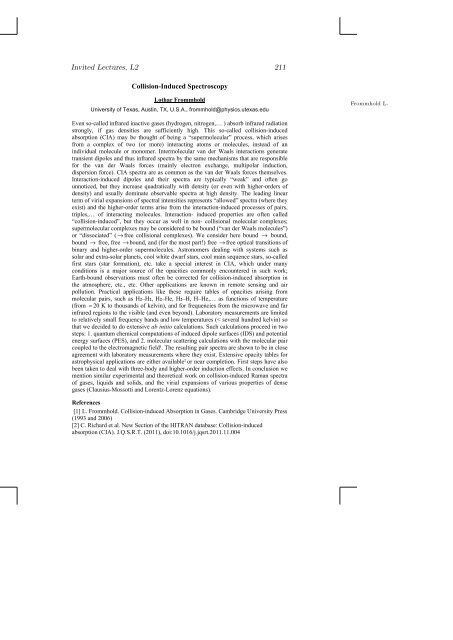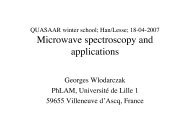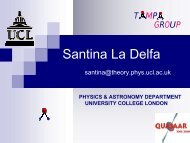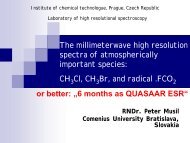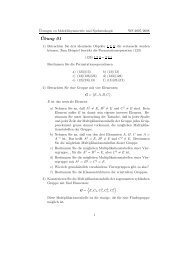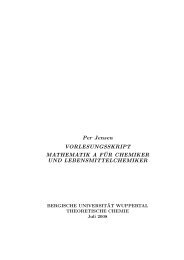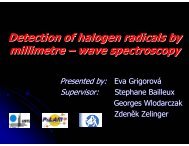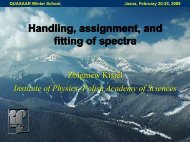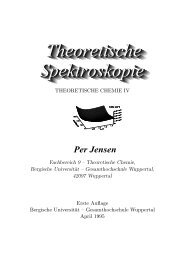Abstract book - Prof. Per Jensen, Ph.D. - Bergische Universität ...
Abstract book - Prof. Per Jensen, Ph.D. - Bergische Universität ...
Abstract book - Prof. Per Jensen, Ph.D. - Bergische Universität ...
- No tags were found...
Create successful ePaper yourself
Turn your PDF publications into a flip-book with our unique Google optimized e-Paper software.
Invited Lectures, L2 211Collision-Induced SpectroscopyLothar FrommholdUniversity of Texas, Austin, TX, U.S.A., frommhold@physics.utexas.eduFrommhold L.Even so-called infrared inactive gases (hydrogen, nitrogen,… ) absorb infrared radiationstrongly, if gas densities are sufficiently high. This so-called collision-inducedabsorption (CIA) may be thought of being a “supermolecular” process, which arisesfrom a complex of two (or more) interacting atoms or molecules, instead of anindividual molecule or monomer. Intermolecular van der Waals interactions generatetransient dipoles and thus infrared spectra by the same mechanisms that are responsiblefor the van der Waals forces (mainly electron exchange, multipolar induction,dispersion force). CIA spectra are as common as the van der Waals forces themselves.Interaction-induced dipoles and their spectra are typically “weak” and often gounnoticed, but they increase quadratically with density (or even with higher-orders ofdensity) and usually dominate observable spectra at high density. The leading linearterm of virial expansions of spectral intensities represents “allowed” spectra (where theyexist) and the higher-order terms arise from the interaction-induced processes of pairs,triples,… of interacting molecules. Interaction- induced properties are often called“collision-induced”, but they occur as well in non- collisional molecular complexes;supermolecular complexes may be considered to be bound (“van der Waals molecules”)or “dissociated” ( ! free collisional complexes). We consider here bound ! bound,bound ! free, free ! bound, and (for the most part!) free ! free optical transitions ofbinary and higher-order supermolecules. Astronomers dealing with systems such assolar and extra-solar planets, cool white dwarf stars, cool main sequence stars, so-calledfirst stars (star formation), etc. take a special interest in CIA, which under manyconditions is a major source of the opacities commonly encountered in such work;Earth-bound observations must often be corrected for collision-induced absorption inthe atmosphere, etc., etc. Other applications are known in remote sensing and airpollution. Practical applications like these require tables of opacities arising frommolecular pairs, such as H2–H2, H2–He, H2–H, H–He,… as functions of temperature(from ! 20 K to thousands of kelvin), and for frequencies from the microwave and farinfrared regions to the visible (and even beyond). Laboratory measurements are limitedto relatively small frequency bands and low temperatures (< several hundred kelvin) sothat we decided to do extensive ab initio calculations. Such calculations proceed in twosteps: 1. quantum chemical computations of induced dipole surfaces (IDS) and potentialenergy surfaces (PES), and 2. molecular scattering calculations with the molecular paircoupled to the electromagnetic field 1 . The resulting pair spectra are shown to be in closeagreement with laboratory measurements where they exist. Extensive opacity tables forastrophysical applications are either available 2 or near completion. First steps have alsobeen taken to deal with three-body and higher-order induction effects. In conclusion wemention similar experimental and theoretical work on collision-induced Raman spectraof gases, liquids and solids, and the virial expansions of various properties of densegases (Clausius-Mossotti and Lorentz-Lorenz equations).References[1] L. Frommhold. Collision-induced Absorption in Gases. Cambridge University Press(1993 and 2006)[2] C. Richard et al. New Section of the HITRAN database: Collision-inducedabsorption (CIA). J.Q.S.R.T. (2011), doi:10.1016/j.jqsrt.2011.11.004


